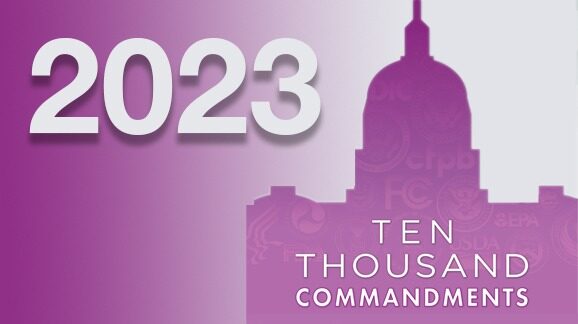Inflation makes regulations even more expensive

The just-released 2023 edition of Wayne Crews’ Ten Thousand Commandments report estimates that the total cost of complying with all federal regulations is $1.94 trillion per year. Regulatory cost estimates, like a lot of government data, have a GIGO, or garbage-in, garbage-out problem. Wayne’s figure is based largely on government-provided data. He takes data agencies bother to make public, which is often garbage. Then he adds it together.
This means, as Wayne often notes, that $1.94 trillion in annual burdens is almost certainly an underestimate. In fact, just since the report was prepared this year, OMB has come out with a three-years-overdue catch-up report that adds at least another $40 billion to acknowledged costs.
Agencies routinely lowball their costs and overstate their benefits. Most rules never get any cost estimates at all. Only about 1 percent of regulations receive full cost-benefit analysis, according to page 18 of this year’s report. The 2021 edition’s “What Comes after Trillion?” section has more on these types of problems.
Many other regulations skip the legally required rulemaking process altogether. This regulatory dark matter includes guidance documents, memoranda, press releases, and blog posts that announce policy changes out of the blue. When challenged, courts usually uphold these dark matter regulations—yet they have almost no transparency regarding costs and are not included in Ten Thousand Commandments’ estimate.
The Biden administration has changed the rules of game to further reduce transparency. Agencies now use a 2 percent discount rate in cost estimates instead of providing estimates for both 3 and 7 percent. That will reduce all future cost estimates going forward.
A Biden Executive Order doubled the threshold for economically significant rules from $100 million of annual impact to $200 million. These rules receive more rigorous cost estimates from the Office of Management and Budget, but the higher threshold means many rules will now dodge that scrutiny, which means many of those rules will not be included in Ten Thousand Commandments going forward.
All these factors make an accurate cost estimate impossible. Any estimate based on government data will almost certainly too low. The case for more regulatory transparency could not be stronger.
One statistical manipulation might be worthwhile when considering regulatory costs: inflation adjustment. That $1.94 trillion headline number hasn’t changed much in recent years, in part because of all those transparency problems. Yet, we are still recovering from the largest inflation in 40 years—and inflation is a government creation.
For example, the 2022 edition of Ten Thousand Commandments, based on 2021 data, has a topline number of $1.927 trillion. CPI inflation during 2022 was 6.5 percent, so adjusting 2021’s costs for 2022’s inflation would yield $2.053 trillion for this year’s Ten Thousand Commandments, which is based on 2022 data. Add in the estimated $72 billion in new costs for 2022 that haven’t yet been affected by inflation, and the new headline number is $2.125 trillion. By that measure, inflation caused a $185 billion increase in regulatory costs.
That are other ways to adjust for inflation. Since the pandemic hit, inflation has devalued the dollar by about 18 percent. The 2020 Ten Thousand Commandments, based on 2019 data (the last full pre-COVID year), estimates $1.9 trillion in annual regulatory costs. That comes out to $2.25 trillion in 2023 dollars, per the Minneapolis Fed’s handy inflation calculator. Add on each subsequent year’s new costs since then and indexing them for inflation as appropriate, and you’ll likely get a number between $2.3 trillion and $2.4 trillion. That amounts to a COVID inflation-caused regulatory tax of at least $350 billion, and possibly as high as $500 billion.
One could also do that as far back as the first Ten Thousand Commandments from back in 1993. Or one could use PCE, the Fed’s preferred inflation measure, instead of CPI.
Just as it is impossible to get an accurate regulatory cost tally from publicly available data, it is impossible to precisely index it for inflation. It is still worth providing at least a ballpark estimate. If anything, it only makes the case for regulatory transparency stronger—and the case for root-to-branch reform of regulatory institutions. Read the 2023 edition of Ten Thousand Commandments here.